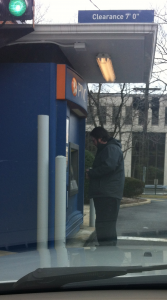 While running a few errands today I had to withdrawal some money from the ATM. It was freezing outside so I want to make use the drive-up machine so not to have to get out of my nice, warm car.
While running a few errands today I had to withdrawal some money from the ATM. It was freezing outside so I want to make use the drive-up machine so not to have to get out of my nice, warm car.
When I arrived there was someone ahead of me using the ATM and I had to wait for him to finish. While I waited I was puzzled by what he was actually doing.
A drive-up ATM is designed for someone to drive-up and do their banking. The machine is positioned in such a way to allow a person operate it from their car. The screen, height, buttons, etc have all been positioned and designed for this intended purpose.
That wasn’t what I saw.
The person in front of me had gotten out of his car, walked up to the ATM, conducted his business, walked back to his car, got in it and drove away.
I thought this guy was crazy! It was freezing outside! Why would anyone get out of a warm car to use a drive-up ATM this way? I don’t know if there is some urban safety lesson about why it’s not safe to use a drive-up ATM from your car, but what I saw got me thinking about design, intent and actual use.
I have been thinking a lot lately about how different things are designed for an intended purpose and how they are actually used.
A school’s database is designed very carefully for an intended purpose, is put in the hands of staff to be used and what happens next is up to the users and how well it is designed. A communications office works on the school’s messaging for go out to its various constituencies through various channels, it is sent out, but what is actually heard and conveyed is depended on if the people actually hold to message.
Whatever the scenario is, through better instruction, better planning and better design, I believe that things should be made to be as simple as possible, whenever possible.
The key to simplicity can be achieved through better design.
But, what if through all of your time and effort in the design process, as you build towards your intended purpose, the actual use of what you are designing for turns our to be different?
The man walking up to the drive-up ATM.
How do you account for this? How do you design for flexibility of use? How do you ensure what you’re working towards is used as intended and can you?
The man at the ATM was able to achieve his goal while using the machine, but the manner in which he did so was counter to the intended use and design of the machine.
As I think about how to design things, to make them simpler to use and understand in my job I will keep the picture of the man coming walking up to the drive-up ATM in my mind. I will ask myself “Is what I am designing flexible enough to be used if one of my parameters in my initial design changes?” – removing the car from the drive-up ATM.
What is lost? What will be missed? What can’t be achieved? What could possibly go wrong?
As we design with simplicity in mind need to remember that no matter how much time and effort we put into the process things may be different from what we expected and we can learn from those experiences.


